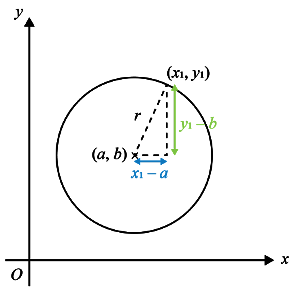Coordinate Geometry (Circles)
In this article, we will learn about circles in coordinate geometry. We will be covering the following:
- Equation of Circle in Standard Form
- Equation of Circle in General Form
- Coordinate Geometry Problems involving Circles
Equation of Circle in Standard Form

The standard form of the equation of a circle with centre \((a,b)\) and radius \(r\) is given by:
\(\begin{align*} (x-a)^2+(y-b)^2 &= r^2, & \text{where} \quad r>0. \end{align*}\)
How is this equation derived?

In the diagram above, the centre of the circle is \((a,b)\).
\((x_1,y_1)\) is any point on the circle.
A horizontal line, \(\begin{align*} x_1-a \end{align*}\), and vertical line, \(\begin{align*} y_1-b \end{align*}\), are drawn such that a right-angled triangle is formed.
The length of the right-angled triangle is \(\displaystyle{x_{1}-a}\) and the height is \(y_1-b\).
By using Pythagoras’ Theorem:
\(\begin{align*} (x_1-a)^2+(y_1-b)^2=r^2. \end{align*}\)
In the above equation, \(r\) is the radius and it is always greater than \(0\).
For equation of a circle in standard form, take note of the following:
- The coefficient of \(x^2\) and \(y^2\) must be \(1\).
- \(r\) should always be squared.
- \(r^2\) should be greater than \(0\).
Question 1:
The equation of a circle is \(\begin{align*} (x-2)^2+(y-1)^2=100 \end{align*}\). Write down its radius and the coordinates of its centre.
Solution:
\(\begin{align*} (x-2)^2+(y-1)^2=100 \end{align*}\)
Rewriting \(r^2\), we get:
\(\begin{align*} (x-2)^2+(y-1)^2=10^2 \end{align*}\)
Therefore,
Centre \(= (2,1)\).
Radius \(= 10\) units.
Question 2:
Find the equation of a circle with centre \(C(-1,0)\) and radius \(4\), leaving your answer in standard form.
Solution:
The standard form of the equation of a circle is:
\(\begin{align*} (x-a)^2+(y-b)^2=r^2 \end{align*}\).
We are given:
Centre \(= (-1, 0)\)
Radius \(= 4\)
So, the equation will be:
\(\displaystyle{\big[x-(-1)\big]^2 + (y-0)^2 = 4^2} \)
Simplifying, we get:
\(\begin{align*} (\;x+1)^2+y^2= 16 \end{align*}\)
Equation of Circle in General Form

The standard form of the equation of a circle can be rewritten in the General Form as:
\(x^2+y^2+2gx+2fy+c=0 \)
where \(g^2+f^2-c>0,\)
\((-g,-f)\) is the centre, and,
\(\sqrt {g^2+f^2-c}\) is the radius.
Question 3:
Find the coordinates of the centre and radius of the circle with equation
\(x^2+y^2+2x-14y+14=0.\)
Solution:
Method 1:
Using The General Form of Equation of Circle
For,
\(x^2+y^2+2x-14y+14=0\)
Let the centre be \((-g,-f)\).
So,
\(\begin{align*} 2g &=2 \\[2ex] -g &= -1 \end{align*}\)
And,
\(\begin{align*} 2f &=-14 \\[2ex] -f &=7 \end{align*}\)
Therefore, centre \(= (\,–1, 7\,)\)
\(\begin{align*} \small{\mathrm{Radius}} &= \sqrt {g^2+f^2-c}\\[2ex] &= \sqrt {1^2+(-7)^2-14} \\[2ex] &= \sqrt {36} \\[2ex] &= 6\small{\text{ units}} \end{align*}\)
Method 2:
By Completing the Square
\(x^2+y^2+2x-14y+14=0\)
We will rewrite as:
\(\begin{align*} x^2+2x+y^2-14y+7^2-7^2+14 &=0 \\ x^2+2x+1^2-1^2+y^2-14y+7^2-7^2+14 &=0 \\ (x+1)^2-1^2+(y-7)^2-7^2+14 &=0 \\ (x+1)^2+(y-7)^2&=1^2+7^2-14 \\ (x+1)^2+(y-7)^2&=36 \\ [\,x-(-1)\,]^2+(y-7)^2&=6^2 \end{align*}\)
Therefore,
Centre \(= (–1, 7).\)
Radius \(= 6\) units.
Question 4:
Find the equation of the circle which touches the x-axis and with a centre of \((3, −2).\)
Solution:

From the sketch, the circle touches the x-axis at \((3, 0).\)
This implies that radius \(\begin{align}\\[2ex] &= 0-(-2)\\[2ex] &= 2 \text{ untis} \end{align}\)
Hence,
\(\begin{align*} (x-3)^2 + \big[ y - ( - 2 ) \big]^2 &= 2^2 \\[2ex] (x-3)^2 + ( y + 2 )^2 &= 4 \end{align*} \)
Conclusion
In this article, we studied the standard form and general form of the equation of circles. Through the questions included in the article, we also learned how to derive the equation of a circle given its centre and radius, and vice versa.
Keep learning! Keep improving!
| Continue Learning | |
|---|---|
| Quadratic Functions in Real-World Context | Equations and Inequalities |
| Logarithmic Functions | Surds |
| Polynomials & Cubic Equations | Partial Fraction |
| Exponential Functions | Coordinate Geometry (Circles) |
| Linear Law | Binomial Theorem |
 SG
SG  VN
VN 









